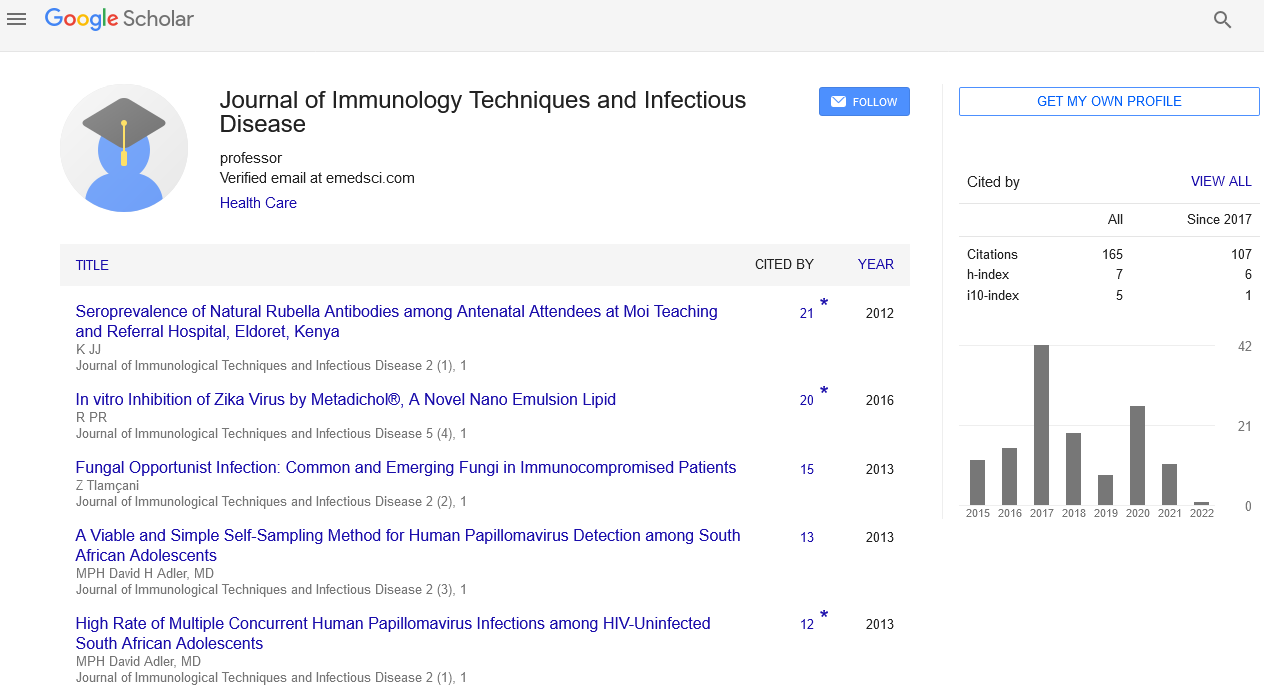Market Analysis, J Immunol Tech Infect Dis Vol: 8 Issue: 2
Market Analysis of 3rd International Conference on Vaccine & Vaccinatio
Ahmed Hegazi
Professor, Dept of Microbiology and Immunology, National Research Center, Dokki, Giza, Egypt, E-mail: ahmedhegazi128@gmail.com
Keywords: Global Vaccine Market
Importance and scope
Vaccination is one of the most successful achievements in medicine. Vaccine Immunology upgrades our comprehension of the resistant reaction in wellbeing and illness by exhibiting critical clinically applicable research, including new creature models for human immunologic infections. Vaccination itself cannot cause formation of disease against which it is intended. Vaccines have historically been the most effective means to fight and eradicate infectious diseases. Vaccinations of animals are used both to prevent their contracting diseases and to prevent transmission of disease to humans. Vaccination given during childhood is generally safe. Effectiveness of vaccination is unambiguously proven by regression up-to clearance of many diseases preventable by vaccination. Limitations to their effectiveness, nevertheless, exist. Influence of vaccination can be best illustrated on eradication of smallpox in the world one of the most contagious and deadly diseases in humans.
Global Vaccine Market
The vaccines market is expected to reach USD 49.27 Billion by 2022 from USD 34.30 Billion in 2017, at a CAGR of 7.5%. The growth of the market is attributed to the rising prevalence of diseases, increasing government and nongovernment funding for vaccine development, and increasing investments by companies.
Newer and more expensive vaccines are coming into the market faster than ever before. Vaccine development: increasing investment. Tripled in value from USD 5B in 2000 to almost USD 24 B in 2013 – Influenza vaccine market: estimated at $2.9 billion in 2011 to $3.8 billion by 2018 – US : $1.6 billion in 2011 to $2.2 billion in 2018. Global market projected to rise to USD 100 B by 2025 .More than 120 new products in the development pipeline. Changing status of the vaccines within the pharmaceutical industry. New business model for vaccines is emerging.

Global Statistics of Vaccines
Global Influenza Vaccine Market – Will Increase to US$ 5.74 Billion by the Year 2022 – Research and Markets.
The study based on Evaluate Pharma survey shows that at the end of 2013 the sales volume of global vaccine market was $ 25.6 billion and is expected to rise to $41.3 billion by 2020.

Global antibacterial vaccination market
Global Antibacterial Drugs Market to 2022: Antibacterial Drug Market will Hit $35.6 Billion by 2022, as Efforts Increase to Tackle Antimicrobial Resistance - Research and Markets.
Global antibacterial vaccination market is expected to experience healthy growth across the forecast period due to rising profits for several classes of drugs. Vaccines will still be the leading revenue-generating drugs in the market in 2022, despite the influx of new protein synthesis inhibitors and the release of several new cell-wall synthesis inhibitors.

Conjugate vaccines to dominate the market in 2017-2018
Predicated on technology, the vaccines market is segmented into conjugate vaccines, inactivated and subunit vaccines, live attenuated vaccines, recombinant vaccines, and toxoid vaccines. In 2018, the conjugate segment is expected to account for the most immensely colossal quota of the vaccines market. The magnification in this market is mainly driven by incrementing investments by the regime of developing countries and elevating prevalence of infectious diseases.
Predicated on disease denotement, the pneumococcal segment is projected to grow at the highest CAGR during the forecast period.
By disease designation, the vaccines market is segmented into pneumococcal disease, influenza, DTP, hepatitis, human papillomavirus (HPV), rotavirus, meningococcal disease, MMR (measles, mumps, and rubella), varicella, polio, dengue, and other disease designations. The pneumococcal segment is expected to register the highest rate during the forecast period. The magnification in this segment can primarily be attributed to the incrementing regime investments in pneumococcal vaccination programs and high prevalence of pneumococcal disease.
Market outlook of the global human vaccine market
Technavio’s market research analyst presages the ecumenical human vaccine market to grow rapidly at a CAGR of more than 11% by 2020. This market’s steady magnification rate is heavily influenced by the inclusion of several pediatric vaccines in the national immunization schedule of sundry countries. This avails in incrementing the consumption of vaccines, which in turn fosters market magnification during the prognosticated period.
America Region
The global vaccines market is segmented based on technology, type, disease indication, end-users, and regions. The conjugate vaccines segment is expected to register the highest growth rate in the vaccines market, by technology, during the forecast period. The high growth in this segment is attributed to the increasing company investments in development of new vaccines.
The vaccines market is expected to reach $48.03 billion by 2021 from USD 32.24 billion in 2016 at a CAGR of 8.3% driven by increasing focus on immunization programs and rising government and nongovernment funding for vaccine development while North America is expected to dominate the market globally.
Europe Region
The Vaccines Europe surveys, provide an insight into the innovation, research and development, employment and manufacturing undertaken by the industry in Europe. With the information collected every two years, Vaccines Europe’s database reveals industrial trends that can assist policy makers and other stakeholders concerned with Europe’s social and economic development.
Europe Influenza Vaccine Market was close to US$ 1Billion. In children vaccine market, United Kingdom is ahead and France holds the second spot. In adult vaccine market United Kingdom and Germany have are on equilibrium.
Asia pacific Region
The Asia-Pacific Cancer Vaccines Market was worth $ 0.46 billion in 2016 and estimated to reach $ 1.05 billion by the end of 2021 with a growing potential of 18.24 %. The Asia-Pacific DNA vaccine market was estimated to be worth $154 million in 2016. The market is predicted to grow at the highest CAGR of 45.85% over the forecast period of 2017-2025, generating $4874 million by its end.
Middle East Region
The Middle East and Africa offer immense potential and opportunities for the vaccine market. Apart from the unmet needs for vaccination, second most important market driving factor are the policies of national Governments and international bodies such as World health organization (WHO).
The market’s trends include strong research pipeline under which number of novel vaccines are being developed such as rubella vaccine, ebola vaccine etc. DNA recombinant technology is also a common technology used in the development of novel acting vaccines.
Associations & Societies Associated with Vaccines in and around Osaka:
• Japanese Society for Immunology(JSI)
• The Japanese Society for Vaccinology
• The Japanese Society of Virology
• The Japanese Association Of Medical Sciences
• Japan Society of Immunology and Reproduction
• Japan Pediatric Society
Global Associations & Societies Associated with Vaccines:
• European Federation of Immunological Societies, Itlay
• The International Society for Interferon and Cytokine Research, USA
• The International Society of Neuroimmunology, Itlay
• British Society for Immunology, UK
• Infectious Diseases Society of America, USA
• The Society for Mucosal Immunology, UK
• The Society for Leukocyte Biology, Germany
• Immune Deficiency Foundation., USA
• The International Union of Immunological Societies, Germany
• European Society of Gene Therapy, Germany
• Federation of African Immunological Societies, Tunisia
• Federation of Clinical Immunology Societies, USA
Universities associated with Vaccines globally:
• Osaka University, Japan
• Angeles University Foundation, Philippines
• Moscow State Medical University, Russia
• Shanghai Medical University, China
• Qingdao University, China
• University of Jordan, Jordan
• Kasr El-Aini Faculty of Medicine, Cairo University, Egypt
• Arak University of Medical Sciences, Iran
• Oman Medical College, Oman
• Riyadh.College of medicine, Saudi Arabia
• University of Minho, Portugal
• Medical University of Lublin, Poland
• Saba University School of Medicine, Netherlands
• University of Western Brittany, France
• University of Southern Denmark, Denmark
• Harvard University, USA
• University of California--San Francisco, USA
• Stanford University, USA
• Yale University, USA
• Johns Hopkins University, USA
Industries associated with Vaccines in worldwide:
• GlaxoSmithKline plc (U.K.)
• Pfizer, Inc. (U.S.)
• Merck & Co., Inc. (U.S.)
• Sanofi Pasteur SA (France)
• CSL Limited (Australia)
• Emergent BioSolutions, Inc. (U.S.)
• Johnson & Johnson (U.S.)
• MedImmune, LLC (U.S.)
• Daiichi Sankyo Company, Limited (Japan).
• Mitsubishi Tanabe Pharma Corporation (Japan)
• Astellas Pharma Inc. (Japan)
• Serum Institute of India (India)
• Bavarian Nordic (Denmark)
Conclusion
Vaccines are necessary — and good hygiene, sanitation, clean water, and nutrition are insufficient for stopping infectious diseases. If we don’t maintain optimum rates of immunization or “herd immunity”, the diseases prevented by vaccination will return. While better hygiene, sanitation and clean water help protect people from infectious diseases, many infections can spread regardless of how clean we are. If people are not vaccinated, diseases that have become uncommon such as pertussis (whooping cough), polio and measles, will quickly reappear.
 Spanish
Spanish  Chinese
Chinese  Russian
Russian  German
German  French
French  Japanese
Japanese  Portuguese
Portuguese  Hindi
Hindi 
